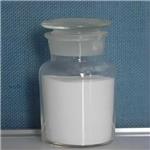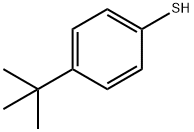Applications of 4-Tert-Butylthiophenol

4-tert-butylthiophenol, a colorless, malodorous liquid, is slightly harmful to water. Hazards identification indicated 4-tert-butylthiophenol may causes eye irritation. Chemical conjunctivitis may be caused. 4-tert-butylthiophenol may cause gastrointestinal irritation with nausea, vomiting and diarrhea. The toxicological properties of this substance have not been fully investigated. respiratory tract irritation could be triggered. The toxicological properties of this substance have not been fully investigated. Chronic injury showed it can produce delayed pulmonary edema. Sensitive to oxidant, 4-tert-butylthiophenol should be sealed a tightly closed container and storage in a cool, dry place.
Despite, 4-tert-butylthiophenol is important scaffold and can be applied to the synthesis of drugs, pesticides and sulfhydryl compounds. Employing 4-tert-butylthiophenol as synthon, a new basket-like Au−Ag bimetallic nanocluster, [Au26Ag22(TBBT)30], was obtained. A rarely reported monomeric “−S−Au−S−” motifs in thiolate-capped metal (Au or Ag) nanoclusters with small size (n < 60) was observed, which would propose new insight into the growth pattern of thiolate-capped metal nanoclusters.
Mimicking individual processes of photosynthesis by use of artificial molecules is an interesting approach for chemists to build up new systems for light-to-chemical energy conversion. It would also be beneficial for research in bioenergetics, where fundamental understanding of chemical energy conversion is a prerequisite. When irradiated with visible light in the presence of 4-tert-butylthiophenol, the quinones were converted to quinols. Such a behavior mimics the function of quinone pools in photosynthesis.
Taking 4-tert-butylthiophenol as substrate, structure of dinitrile (bidentate dinitriles), which includes two thioethereal sulfurs in the bridging group, has been synthesized in three reaction steps with an overall yield of 4.3%. It is generally understood that the coordination bond between low-valent transition metals and sulfur donors is much stronger than that between low-valent transition metals and oxygen donors. Judging from the IR and NMR spectra, the -CN group in the complexes serves as a s-donor and the thioethereal sulfurs in the bridging group are not coordinated to the metal atoms.
References
[1] Nagata, T.; Kikuzawa, Y. An approach towards artificial quinone pools by use of photoand redox-active dendritic molecules. Biochimica et Biophysica Acta, 2007, 1767, 648–652.
[2] Sakata, K.; Watanabe, K.; Kobayashi, I.; et al. SYNTHESIS AND SPECTROSCOPIC PROPERTIES OF COPPER(I) AND SILVER(I) COMPLEXES WITH A BIDENTATE DINITRILE HAVING TWO THIOETHER SULFURS IN THE BRIDGING GROUP. Synthesis and Reactivity in Inorganic and Metal-Organic Chemistry, 2001, 31:7, 1217-1227.
[3] Li, H.; Song, Y.; Lv, Y.; et al. Unexpected Observation of Heavy Monomeric Motifs in a Basketlike Au26Ag22 Nanocluster. Inorg. Chem., 2019, 58, 1724−1727.
You may like
Related articles And Qustion
See also
Lastest Price from 4-TERT-BUTYLTHIOPHENOL manufacturers

US $1786.00/Kg2024-09-06
- CAS:
- 2396-68-1
- Min. Order:
- 1Kg
- Purity:
- 98
- Supply Ability:
- 500 Kg

US $60.00-600.00/kg2024-08-27
- CAS:
- 2396-68-1
- Min. Order:
- 10kg
- Purity:
- 0.99
- Supply Ability:
- 20tons



